Protective Techniques for Drilling into Trees Without Harming Them

Drilling into a tree can be a necessary procedure for various reasons, such as installing tree house supports, conducting research, or fixing a damaged trunk. However, it is crucial to use protective techniques to minimize the harm to the tree and ensure its longevity. By following the proper methods and taking precautions, it is possible to drill into a tree without causing significant damage.
One of the most important protective techniques is selecting the right location for drilling. It is essential to avoid drilling into the main trunk, as this can severely affect the tree’s stability and health. Instead, it is recommended to choose a branch or a less vital part of the tree. This way, the impact of the drilling will be minimized, and the tree will have a better chance of recovering.
Another crucial aspect of drilling into trees without harm is using the correct tools and techniques. It is recommended to use a specialized drill bit designed for tree drilling, which is less likely to cause excessive damage. Additionally, it is crucial to drill at a slow speed and with consistent pressure to reduce the risk of splintering or cracking the tree’s wood. Taking breaks during drilling and allowing the tree to rest can also prevent overheating and further damage.
Furthermore, it is essential to properly clean and care for the drilled area. After drilling, it is recommended to gently clean the hole with a brush to remove any wood debris or sawdust. This will prevent potential infections or infestations in the tree. Applying a tree wound dressing or sealant, if necessary, can help protect the drilled area and promote healing.
Why It’s Important to Protect Trees When Drilling
When drilling into trees, it is crucial to take measures to protect them to ensure their long-term health and well-being. Trees provide numerous benefits to our environment and communities, such as improving air quality, reducing stormwater runoff, and providing shade and habitat for wildlife. Therefore, it is essential to minimize any potential harm that drilling may cause.
Maintaining Tree Health
Drilling into a tree can damage its bark, which serves as its protective barrier against pests, diseases, and environmental stressors. Once the bark is compromised, the tree becomes vulnerable to infestations and infections that can weaken or even kill it. By implementing protective techniques, such as using proper drilling equipment and drilling in the right locations, we can minimize the risk of harm to the tree’s bark and preserve its health.
Preventing Structural Damage
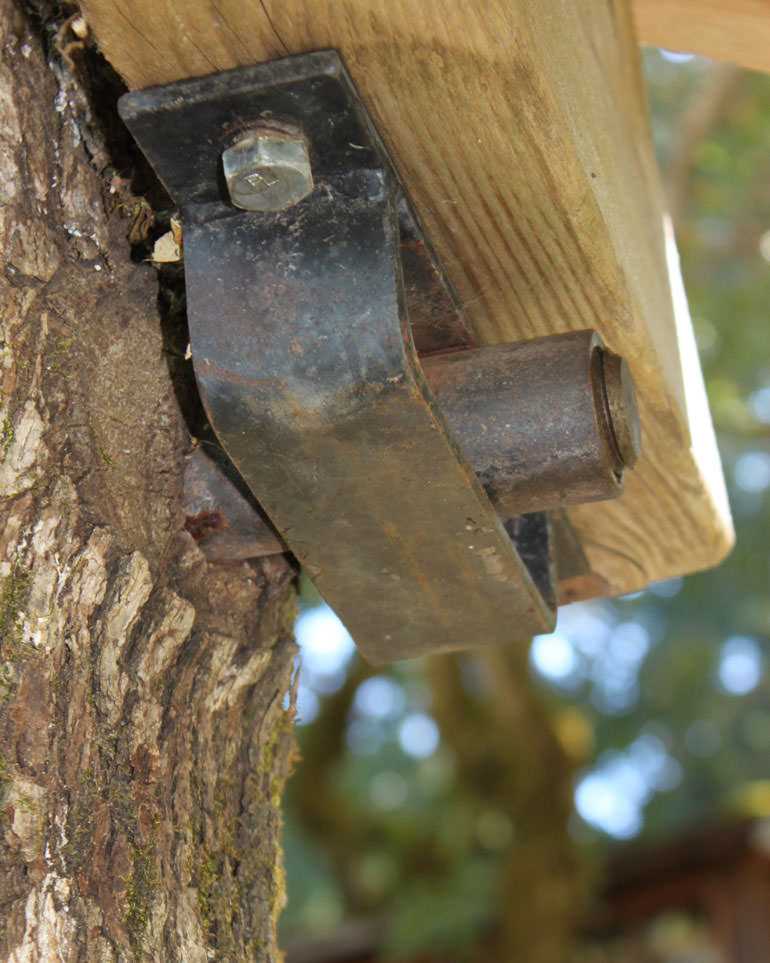
Drilling into a tree without taking precautions can also lead to structural damage. Trees have a sophisticated system of roots, branches, and trunk that provides stability and supports their growth. When drilling, there is a risk of damaging these vital components, which can weaken the tree’s overall structure. This damage may manifest in the form of leaning, cracking, or even collapse of the tree. By using appropriate protective techniques, such as avoiding drilling near critical structural elements, we can prevent potential damage and ensure the tree’s long-term stability.
Promoting Long-Term Growth
Protecting trees when drilling is also important for their long-term growth. Trees have a slow growth rate, and any damage inflicted during drilling can impede their development and limit their ability to reach their full potential. By taking measures to protect trees, such as using tree-friendly drilling methods and equipment, we can support their growth and ensure that they continue to provide us with their valuable benefits for years to come.
Preserving the Urban Forest
Drilling into trees in urban areas has a cumulative effect on the overall health and sustainability of the urban forest. Urban forests play a vital role in mitigating urban heat island effect, improving air quality, and providing shade for pedestrians and buildings. By protecting trees when drilling, we contribute to the preservation and growth of the urban forest, creating a more sustainable and livable environment for both humans and wildlife.
Conclusion
Protecting trees when drilling is of utmost importance to ensure their long-term health, preserve their structural integrity, promote long-term growth, and contribute to the sustainability of our urban forests. By implementing tree-friendly drilling techniques and equipment, we can minimize the potential damage while enjoying the benefits that trees provide to our environment and communities.
Understanding the Impact of Drilling on Trees
When considering drilling into trees, it is important to understand the potential impact it can have on the health and well-being of the tree. Drilling into a tree can be necessary for various reasons, such as installing hardware, attaching supports, or conducting scientific research. However, it is crucial to take precautions to avoid causing harm.
Potential Damage
Drilling into a tree can potentially cause physical damage, which may have lasting effects on the tree’s health. The main areas of concern when drilling into a tree are the bark and the vascular system.
Bark: The bark of a tree acts as a protective layer, defending against potential threats such as pests, diseases, and extreme weather conditions. Drilling into the bark can disrupt this protective barrier, leaving the tree more vulnerable to these threats.
Vascular System: The vascular system of a tree is responsible for transporting water, nutrients, and sugars throughout the tree. When drilling into a tree, there is a risk of damaging the vascular system, which can impede the tree’s ability to thrive and survive.
Precautions
Before drilling into a tree, it is important to carefully assess the necessity of the action and consider alternative methods if possible. If drilling is unavoidable, there are several precautions that can be taken to minimize the impact on the tree:
- Location: Choose a drilling location where the impact on the tree will be minimal. Avoid drilling near major branches or the trunk, as these areas are more critical for the tree’s overall health.
- Size of Hole: Keep the size of the drilled hole as small as possible to reduce the potential damage to the tree. Consider the specific needs of the project or research activities and choose an appropriate size.
- Clean Tools: Ensure that the drilling tools are clean and free of dirt, debris, or any contaminants that may introduce infections or diseases to the tree.
- Proper Drilling Technique: Use a drill with a sharp drill bit and apply steady pressure. Avoid excessive force or prolonged drilling, as this can cause unnecessary damage to the tree.
Monitoring and Care
After drilling into a tree, it is crucial to monitor the tree closely for any signs of stress or decline. Keep an eye out for changes in leaf color, wilting leaves, or any physical damage near the drilled area. If any negative effects are observed, it is recommended to consult with an arborist or tree care professional to assess the situation and provide appropriate care.
By having a thorough understanding of the potential impact of drilling on trees and taking necessary precautions, it is possible to minimize harm and maintain the overall health and vitality of trees.
Preparing the Tree for Drilling
Before drilling into a tree, it is crucial to take certain steps to ensure the tree’s health and minimize any potential damage. The following are some key preparatory measures to consider:
1. Inspecting the Tree
Prior to drilling, thoroughly examine the tree to assess its overall health and identify any existing wounds or diseases. It is essential to avoid drilling into areas with existing damage or decay as this can further weaken the tree and increase the risk of infection.
2. Choosing the Right Location
Selecting the appropriate spot for drilling is vital to minimize tree damage. Look for a location that is free from any major branches, wounds, or areas of decay. Choose a spot where the drilling will have the least impact on the overall structure and stability of the tree.
3. Marking the Drilling Site
Using a non-toxic marker or chalk, carefully mark the exact location where you plan to drill. This will help ensure accuracy and prevent any unnecessary exploration into different areas of the tree.
4. Cleaning and Sterilizing the Drill Bit
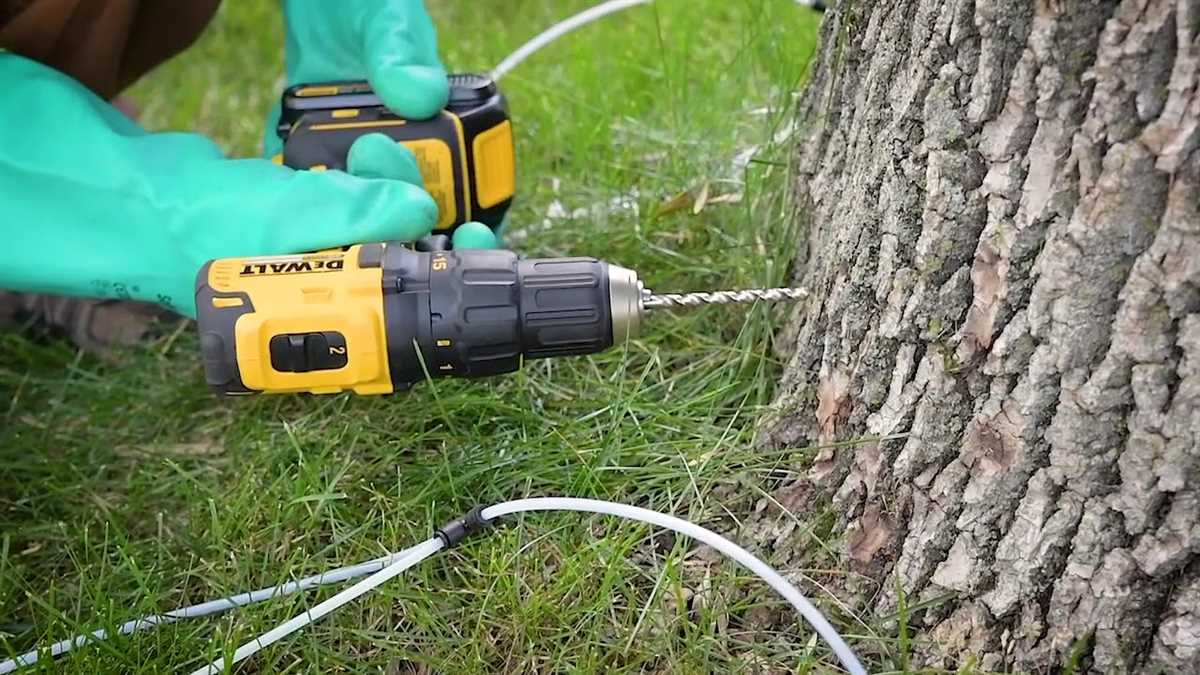
Prior to drilling, it is important to clean and sterilize the drill bit to prevent the potential spread of diseases or pathogens from one tree to another. Wipe down the drill bit with a disinfectant solution or isopropyl alcohol to reduce the risk of contamination.
5. Obtaining Necessary Permissions
Depending on local regulations and the specific circumstances, you may need to obtain permissions or permits before drilling into a tree. Check with the appropriate authorities or consult an arborist to ensure compliance with any legal requirements.
6. Safeguarding the Surrounding Area
Prior to drilling, take steps to protect the surrounding area from any falling debris or damage. Clear away any loose branches or objects that could be dislodged during the drilling process. Consider using safety barriers or caution tape to restrict access and minimize potential risks.

7. Seeking Professional Advice
If you are unsure about drilling into a tree or lack the necessary expertise, it is advisable to seek professional advice. Consulting an arborist or tree specialist can help ensure that the drilling process is conducted safely and with minimal impact on the tree’s health.
Choosing the Right Tools for Tree Drilling
When it comes to drilling into trees, using the right tools is crucial to ensure the health and safety of the tree. Here are some important factors to consider when choosing the tools for tree drilling:
1. Drill Bit
Selecting the appropriate drill bit is essential for tree drilling. It is recommended to use a sharp and clean drill bit that is specifically designed for wood drilling. A spade bit or a paddle bit with a flat, wide tip is commonly used for drilling into trees. These types of bits provide a smoother drilling experience and minimize damage to the tree.
2. Drill Size
The size of the drill bit should be chosen carefully based on the purpose of drilling. For small holes, such as for inserting small screws or nails, a drill bit with a diameter of 1/8 inch to 1/4 inch can be used. For larger holes, such as for tree injections or installing hardware, a drill bit with a diameter of 1/2 inch to 1 inch may be required. It is important to avoid drilling a hole that is too large, as it can cause significant harm to the tree.
3. Drill Speed and Pressure

When drilling into a tree, it is essential to maintain a moderate drill speed and apply gentle pressure. Using high-speed settings or exerting excessive force can lead to unnecessary damage to the tree. It is recommended to use a cordless drill with adjustable speed settings to have better control over the drilling process.
4. Drill Depth
Determining the appropriate drill depth is crucial to avoid penetrating too deeply into the tree. The drill bit should only penetrate the outer layers of the tree, such as the bark and cambium layer, and should not go beyond the living tissue. It is recommended to measure the drill bit or mark it with tape to ensure the desired drilling depth is achieved.
5. Cleanliness and Sterilization
Before drilling into a tree, it is important to ensure the tools are clean and sterilized. Dirty or contaminated tools can introduce pathogens or pests into the tree, leading to infections or infestations. Clean the drill bit and other tools with a disinfectant solution before and after each use to minimize the risk of spreading diseases or pests.
6. Safety Equipment
Lastly, don’t forget to wear appropriate safety equipment when drilling into trees. Safety goggles, gloves, and ear protection are recommended to protect yourself from potential hazards and flying debris.
By considering these factors and using the right tools, you can successfully drill into trees without harming them, ensuring their continued health and vitality.
Techniques to Minimize Damage During Drilling
Drilling into trees can be necessary for various reasons, such as installing support structures or conducting scientific research. However, it is essential to minimize the damage to the tree during the drilling process. By following these techniques, you can help protect the tree and ensure its long-term health.
1. Use the Right Tools
Using the right tools is crucial to minimize damage during drilling. A drill with a small diameter bit is recommended as it creates a smaller hole and reduces the impact on the tree. Additionally, using a low-speed drill helps to prevent excessive heat generation, which can damage the surrounding tissues.
2. Locate the Best Entry Point
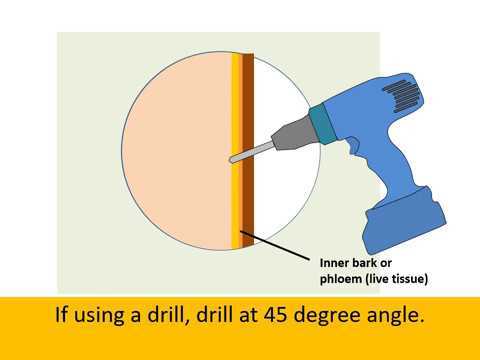
Before drilling, locate the best entry point on the tree. Choose a spot away from major branches or critical trunk areas. Identify areas with less growth and fewer vital functions to minimize potential harm to the tree.
3. Drill at the Correct Angle
Drilling at the correct angle is essential to minimize damage. Aim for a slight incline rather than drilling straight into the tree. This angle allows gravity to aid in the flow of water and nutrients, reducing the risk of damage to the tree’s vascular system.
4. Drill Carefully and Slowly
Take your time while drilling and exercise caution to minimize damage. Apply gentle pressure and use slow, continuous drilling motions. Avoid sudden movements or excessive force, as it can cause unnecessary harm to the tree.
5. Clean the Drill Hole Properly
After drilling, it is essential to clean the drill hole properly. Remove any debris or wood shavings from the hole to prevent potential infections or decay. Use a soft brush or a stream of water to clean the hole thoroughly.
6. Apply Wound Dressing
To further protect the tree, apply a suitable wound dressing after drilling. Wound dressings help minimize the risk of infections and promote faster healing. Consult with a professional or arborist to select the appropriate dressing for the tree species.
7. Monitor the Tree’s Health
Even with all precautions, it is crucial to monitor the tree’s health after drilling. Regularly inspect the drilled area for any signs of decay, discoloration, or abnormal growth. If you notice any issues, consult a professional arborist for further guidance.
By following these techniques, you can minimize the damage during drilling and ensure the tree’s continued well-being. Remember that seeking professional advice is always recommended to ensure the best outcome for the tree.
Best Practices for Drilling into Trees
1. Choose the Right Drill Bit
When drilling into a tree, it is essential to use the correct drill bit. A spade or paddle bit is ideal for drilling holes in trees. These bits have a flat or slightly concave shape, which minimizes damage to the tree’s bark and wood. Avoid using twist bits or auger bits, as they can cause significant harm to the tree.
2. Select the Proper Drill Size
Using the right drill size is crucial to avoid unnecessary damage to the tree. The diameter of the hole should match the size of the nail, screw, or hardware you intend to insert into the tree. It is recommended to measure the hardware beforehand and choose a drill bit that matches its size.
3. Drill at the Right Depth
Drilling at the correct depth is essential to protect the tree. It is recommended to drill no more than 1.5 inches into the tree’s trunk. This depth ensures that the hardware is securely installed without causing excessive harm to the tree. It is essential to avoid drilling too close to the tree’s heartwood, as this can compromise its structural integrity.
4. Use Slow and Steady Pressure
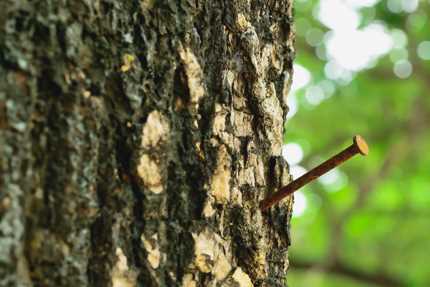
When drilling into a tree, it is important to apply slow and steady pressure. This technique helps prevent the drill bit from slipping or causing excessive damage to the tree’s bark. Applying too much pressure or drilling too quickly can result in splintering or splintering of the wood, which can harm the tree.
5. Clean the Hole and Apply Protective Sealant
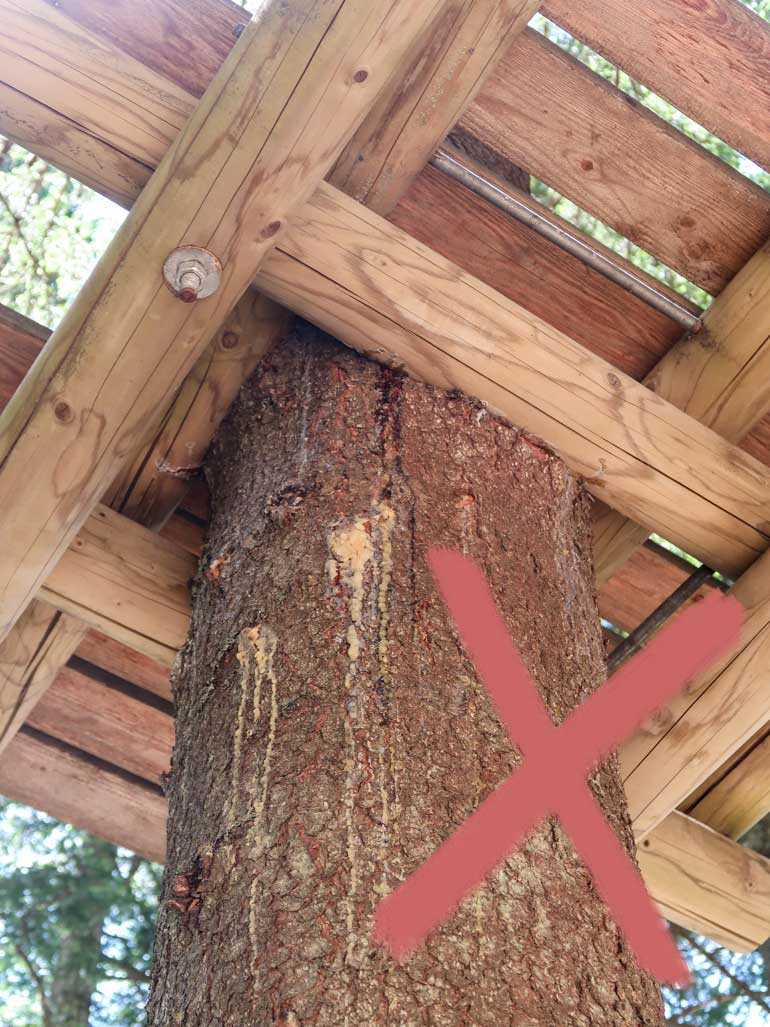
After drilling into the tree, it is essential to clean the hole to remove any wood chips or debris. Use a brush or compressed air to clean the hole thoroughly. Once the hole is clean, apply a protective sealant to prevent moisture and pests from entering the tree. Tree wound sealants or pruning paints are commonly used to seal drilled holes.
6. Avoid Drilling in Vital Areas
To prevent harm to the tree, it is crucial to avoid drilling in vital areas. These areas include the tree’s crown, where new growth occurs, and the flare at the base of the trunk. Drilling in these areas can disrupt the tree’s natural processes and compromise its overall health. Consult with an arborist if you are unsure about where to drill.
7. Monitor the Tree’s Health
After drilling into a tree, it is important to monitor its health regularly. Inspect the drilled area for any signs of decay, disease, or pest infestation. If you notice any issues, contact a professional arborist to assess the situation and provide necessary treatment.
By following these best practices, you can safely drill into trees without causing harm and ensure the health and longevity of the tree.
Using Protective Barriers When Drilling
When drilling into trees, it is crucial to take precautions to protect the tree from any potential damage. One effective technique is using protective barriers. These barriers can help prevent the drill bit from causing harm to the tree trunk or branches.
Here are some commonly used protective barriers when drilling into trees:
- Bamboo or Plastic Sleeves: These sleeves can be placed around the area where drilling will occur. The sleeves act as a barrier between the drill bit and the tree, reducing the risk of damage. They are lightweight, easy to install, and can be reused.
- Tape or Strips: Another method is to use tape or strips to create a protective barrier around the drilling site. This can be achieved by wrapping tape or strips of cloth or plastic around the tree trunk, creating a buffer zone for drilling. Ensure that the tape or strips are securely fastened to avoid any movement during drilling.
- Foam or Rubber Padding: Foam or rubber padding can also be used to create a protective barrier. Cut a piece of foam or rubber and attach it around the area where drilling will occur. This padding will absorb any impact from the drill bit and minimize the risk of damage to the tree.
It is important to note that regardless of the protective barriers used, care should be taken to minimize drilling pressure and avoid going too deep into the tree trunk. Additionally, regular inspections of the protective barriers should be conducted to ensure they are still intact and providing proper protection.
Benefits of using protective barriers:
- Protects the tree from potential damage during drilling
- Reduces the risk of infection or disease entering the tree through drilled holes
- Allows for a safer drilling process
- Ensures the longevity and health of the tree
By using protective barriers when drilling into trees, you can minimize the risk of harm to the tree and ensure its continued health and growth.
Monitoring and Assessing Tree Health After Drilling
Visual Inspection
One of the most common methods of monitoring and assessing tree health after drilling is through visual inspections. This involves examining the tree for any noticeable signs of damage or stress, such as wilting leaves, discoloration, or the presence of pests.
Measuring Growth
Another way to assess tree health is by measuring growth. This can be done by monitoring the tree’s overall size, height, and diameter. A healthy tree will continue to grow and show signs of new growth, while a stressed or damaged tree may have limited or stunted growth.
Soil Testing
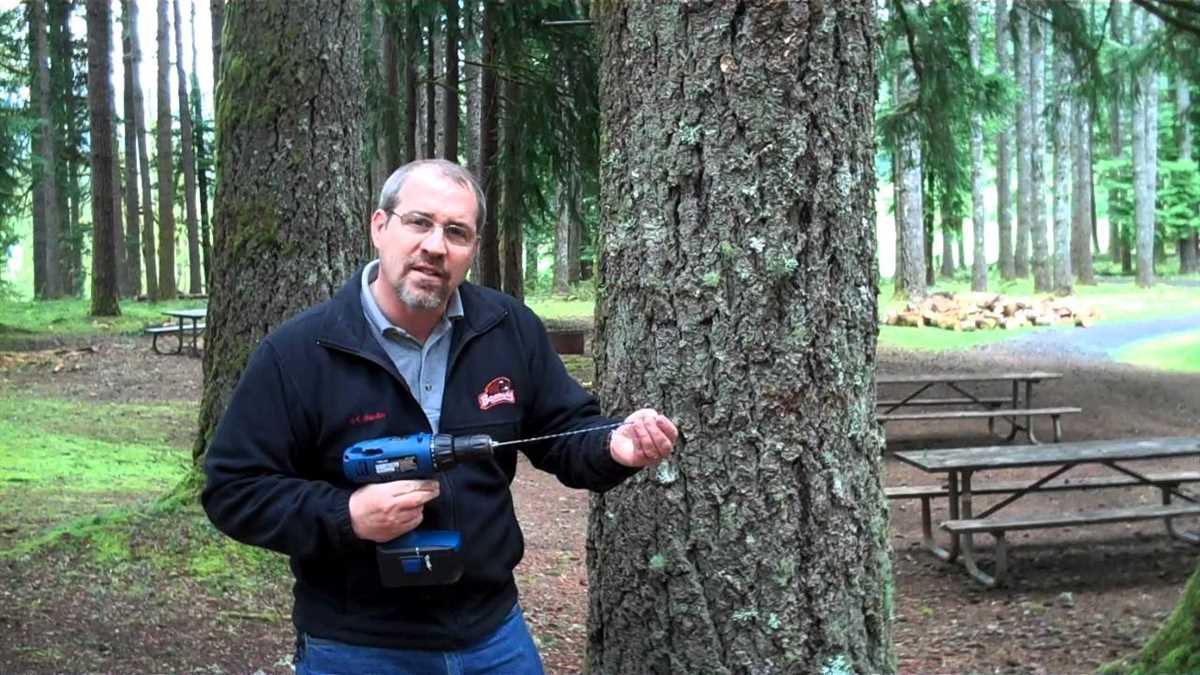
Since drilling into a tree can disrupt the root system, it is important to assess the health of the soil surrounding the tree. Soil testing can help determine if the soil is providing adequate nutrients and moisture for the tree. pH levels, nutrient levels, and soil compaction can all be measured through soil testing.
Assessing Canopy Density
The density of a tree’s canopy is another indicator of tree health. A healthy tree will have a full and lush canopy, while a stressed or damaged tree may have thinning or sparse foliage. Assessing the canopy density can be done through visual inspection or by using specialized tools, such as a densiometer.
Tracking Pest and Disease Presence
Drilling into a tree can create entry points for pests and diseases. Therefore, it is important to monitor and track the presence of any pests or diseases that may be affecting the tree’s health. This can be done through regular inspections or by setting up traps or monitoring devices to capture and identify pests.
Consulting with a Tree Care Professional
If there are any concerns about the health of a tree after drilling, it is always recommended to consult with a tree care professional. These professionals have the knowledge and expertise to assess tree health and provide appropriate recommendations for treatment or further monitoring.
Conclusion
Monitoring and assessing tree health after drilling is crucial to ensure the well-being of the tree. Visual inspections, measuring growth, soil testing, assessing canopy density, tracking pest and disease presence, and consulting with a tree care professional are all important techniques to consider when monitoring and assessing tree health after drilling.
Working with Professionals for Tree Drilling
When it comes to drilling into trees for various purposes, it is important to work with professionals who have the knowledge and experience necessary to protect the tree’s health and ensure its continued growth.
Professional tree drilling services have the tools and techniques to safely and effectively drill into trees without causing harm. They understand the biology of trees and how to minimize any potential damage during the drilling process.
Here are some reasons why working with professionals for tree drilling is essential:
Expertise and Experience
Professional tree drillers have extensive knowledge and experience working with trees. They understand the specific needs and vulnerabilities of different tree species, allowing them to choose the appropriate drilling technique and location to minimize damage.
They are also trained in the latest industry standards and best practices for tree drilling, ensuring that the job is done correctly and safely.
Specialized Tools and Equipment
Professional tree drilling services have access to specialized tools and equipment designed specifically for drilling into trees. These tools are designed to minimize damage to the tree and promote quick healing.
They also have the necessary safety equipment to ensure the well-being of their workers and to comply with industry regulations.
Tree Health Monitoring
After drilling into a tree, professionals will monitor the tree’s health to ensure that it is recovering properly. They will carefully track the healing process and take necessary steps to promote healing, such as applying tree wound dressings or providing additional support.
If any signs of distress or infection are detected, they can take appropriate measures to address the issue and prevent further damage.
Protection of Surrounding Vegetation
Working with professionals for tree drilling also ensures the protection of surrounding vegetation. They will take precautions to prevent damage to nearby plants and minimize disruption to the surrounding ecosystem.
They will also clean up after the drilling process, removing any debris or waste materials to leave the area in a clean and tidy condition.
- Overall, working with professionals for tree drilling is crucial to protect the health and well-being of the tree and the surrounding environment.
- Their expertise, experience, specialized tools, and commitment to tree health monitoring ensure that the drilling process is done with utmost care and precision.
- By choosing to work with professionals, you can have peace of mind knowing that your tree will be well taken care of and will continue to thrive for years to come.
FAQ:
What are some protective techniques for drilling into trees without harming them?
There are several protective techniques that can be used when drilling into trees. One common technique is to use a special drill bit designed for tree drilling, which has a narrow diameter to minimize damage to the tree. Another technique is to use a tree injection system, which allows the drilling to take place without causing harm to the tree. Additionally, it is important to drill at the correct depth and angle to avoid hitting vital parts of the tree.
Are there any specific tools or equipment recommended for drilling into trees?
Yes, there are specific tools and equipment that are recommended for drilling into trees. One such tool is a tree drill bit, which is designed to have a narrow diameter to minimize damage to the tree. It is also important to use a high-quality drill and ensure that it is properly maintained. Additionally, a tree injection system can be used, which requires a specialized injector to safely drill into the tree without harm.
What precautions should be taken when drilling into trees?
When drilling into trees, it is important to take certain precautions to avoid causing harm. First, make sure to identify any vital parts of the tree, such as the cambium layer, and avoid drilling into them. Second, use a drill bit with a narrow diameter to minimize damage. Third, ensure that the drill is at the correct angle and depth to avoid hitting critical areas. Finally, it is recommended to consult with a professional arborist or tree care expert before drilling into a tree.
Can drilling into a tree cause permanent damage?
Yes, drilling into a tree can cause permanent damage if not done properly. Drilling into vital parts of the tree, such as the cambium layer, can disrupt the flow of nutrients and water, which can harm the tree’s health. Additionally, drilling at the wrong angle or depth can damage important roots or branches, leading to long-term consequences for the tree. It is essential to take proper precautions and use protective techniques to minimize the risk of permanent damage.
Is it possible to drill into a tree without harming it?
Yes, it is possible to drill into a tree without harming it if the proper protective techniques are used. Using a tree drill bit with a narrow diameter, drilling at the correct angle and depth, and avoiding vital parts of the tree are all important steps to ensure minimal harm. Additionally, utilizing a tree injection system can provide a safe and effective way to drill into the tree without causing damage. Consulting with a tree care professional can also help to ensure that drilling is done without harm.
What are the benefits of drilling into a tree?
Drilling into a tree can provide several benefits, depending on the purpose of the drilling. One common benefit is the ability to inject nutrients or treatments directly into the tree. This can help to improve the health and vitality of the tree, especially in cases of nutrient deficiencies or pest infestations. Drilling can also be used for research purposes, such as to collect samples or monitor tree health. When done properly and with the right protective techniques, drilling can be a valuable tool for tree care and management.
Are there any alternatives to drilling into trees for tree care or treatment?
Yes, there are alternatives to drilling into trees for tree care or treatment, depending on the specific needs and circumstances. One alternative is to use tree injection or infusion systems, which involve injecting treatments into the tree without the need for drilling. Additionally, foliar sprays or soil applications can be used to deliver nutrients or treatments to the tree. It is important to consult with a tree care professional to determine the most appropriate method for tree care or treatment in a specific situation.
Video:










